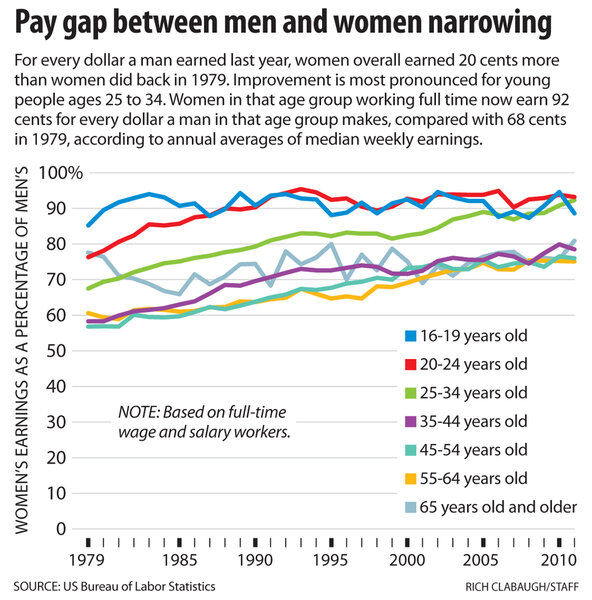Gender pay gap is eroding, especially among younger women, US data show
Loading...
| Boulder, Colo.
Women are, slowly, making inroads in closing the gender pay gap – an issue that got some attention in the presidential campaign this fall, as President Obama touted his signing of the Lilly Ledbetter Fair Pay Act, and both candidates answered a question on the topic in the town-hall debate.
According to the latest numbers released by the Bureau of Labor Statistics (BLS) last week, based on the weekly earnings of full-time wage and salary workers, women now earn 82 percent as much as men – up from 64 percent in 1980.
In recent discussions of the wage gap, a different figure – 77 percent – has been widely cited. That figure is also accurate; but the measure, which comes out in the spring, looks at median annual earnings for full-time year-round workers; it includes self-employed workers, which the weekly numbers exclude, and excludes seasonal workers. The figures are based on the same raw BLS data.
Most notably, in the BLS numbers released the day after Thanksgiving, the earnings of women between the ages of 25 and 34 have shot up fairly substantially over the past 32 years, from 69 percent of men's earnings in 1980 to 92 percent in 2011.
The gap still widens, though, as women age – a sign that while many young women enter the workforce on a more equal playing field with their male counterparts, they still tend to fall behind on income as they age.
"A tremendous amount of progress has been made [on the earnings gap between men and women], in many ways more than I thought would be made," says Heidi Hartmann, president of the Institute for Women's Policy Research in Washington. The wage gap, she notes, has been cut nearly in half. "It's not good enough, but it's progress," Ms. Hartmann says.
And progress has also been made on the sex segregation of the labor market, with many previously male-dominated fields – including law, banking, medicine, and civil service jobs like bus drivers and mail carriers – opening up to women.
Both those trends are largely the result of women's increased entry into higher education, in which female graduates have outnumbered male graduates since the mid 1980s.
But Hartmann and others also caution that there's still a tremendous amount of work to do before women have true equality in the workforce.
A recent study from Catalyst, a nonprofit New York-based organization that promotes women in the business world, found that women in the business world are offered fewer of the "hot jobs" – those jobs with high visibility that are central to an organization's mission and tend to lead to promotions down the road.
The Catalyst survey of top MBA grads found that men led projects with budgets more than twice the size of women's, with teams that were more than three times as large, and that posed a higher risk to the company. Men also had roles with significantly more critical responsibility – one reason, Catalyst suggests in its analysis, for the persistent gender gap at senior levels that exists in the business world.
Another major factor in continuing inequities is the lack of parental supports, says Hartmann.
The United States is one of the only countries in the world – and the only industrialized nation – she notes, without any guaranteed paid maternity leave. (Lesotho, Papua New Guinea, and Swaziland are included in the countries that have guaranteed paid maternity leave.)
And without the subsidized child-care costs that many nations have, many mothers have to factor child-care costs into their decision whether to return to work, and often take a leave of absence – which they're later often penalized for when they do return to work.
And in a labor market in which about half of US workers get no paid sick time at all, women are still most often the ones to skip work – and forgo pay – to stay home with sick children or other family members.
Still, women are slowly chipping away at the wage gap. And while paid parental leave remains elusive for many US workers, women have won a number of legal gains in the past 35 years that have helped contribute – most notably the Pregnancy Discrimination Act of 1978 and the Family and Medical Leave Act of 1993 (which requires most employers to provide unpaid, job-protected leave of up to 12 weeks for family or medical reasons).
Some smaller employers are exempt from even these basic protections, notes Hartmann, "but the fact that we have them is better than [nothing]."






